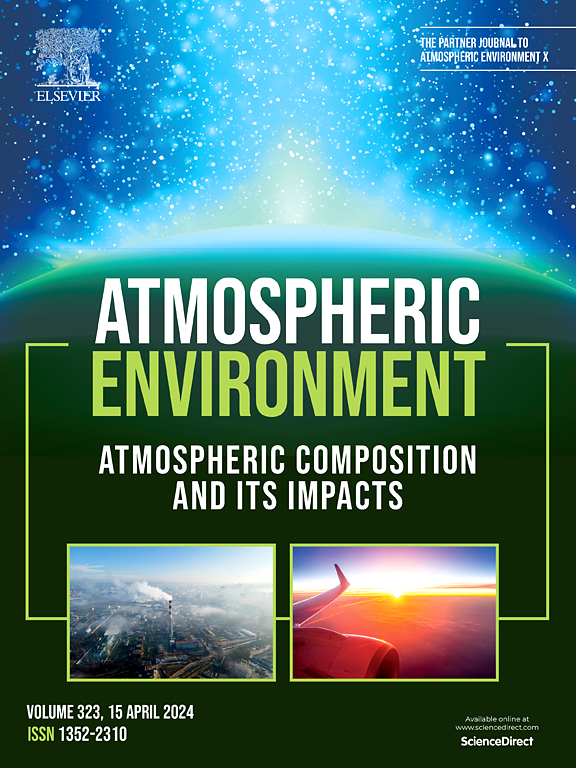Impact of the actinic radiative effect of scattering aerosols on ozone vertical distribution in the Pearl River Delta, China
IF 4.2
2区 环境科学与生态学
Q2 ENVIRONMENTAL SCIENCES
引用次数: 0
Abstract
Currently, the Pearl River Delta (PRD) region faces the concurrent issues of aerosol and ozone pollution. Aerosols have a significant impact on the actinic radiative flux, which greatly influences the formation of ozone. This study quantitatively estimates the impact of scattering aerosol actinic radiative effect on the vertical distribution of ozone and secondary pollutants during a double high pollution episode in October 2012 using a localized parameterization formula for aerosol extinction profiles and the Weather Research Forecast–Community Multiscale Air Quality (WRF-CMAQ) model. Scattering aerosols can increase photolysis rates when the Aerosol Optical Depth is low. Aerosol actinic radiative effect reduces ground level ozone and PM2.5 in the morning. In the core area of the PRD, the reduction in ozone reaches up to 20 ppb, while PM2.5 decreases by 4–8 μg/m3. But it increases ozone and PM2.5 levels in the upper and middle layers of the boundary layer during midday and the afternoon, with ozone increasing by 5–20 ppb and PM2.5 by 1–2 μg/m3. Enhanced oxidizing capacity promotes the generation of sulfate and secondary organic aerosols, further increasing scattering aerosols and forming a positive feedback loop. The acinic radiative effect of aerosols lead to a diurnal variation in the reduction of surface ozone concentration, with a more pronounced effect in the morning. When radiation is weak in the morning and there is sufficient precursor for ozone, changes in radiation have a greater impact on ozone. As radiation becomes stronger, even though aerosols attenuate the radiation, there is still sufficient radiative flux to drive actinic reactions, and the impact of scattering aerosols on surface ozone concentration at midday is not significant. The mechanisms by which aerosol actinic radiative effect influence secondary organic aerosols (SOA) and sulfates are similar to those for ozone described above.

散射气溶胶的辐射效应对珠江三角洲臭氧垂直分布的影响
目前,珠江三角洲(PRD)地区同时面临着气溶胶和臭氧污染的问题。气溶胶对光辐射通量有显著影响,而光辐射通量又极大地影响臭氧的形成。本研究利用气溶胶消光剖面的局部参数化公式和天气研究预报-社区多尺度空气质量(WRF-CMAQ)模式,定量估算了散射气溶胶光辐射效应在2012年10月双高污染期间对臭氧和二次污染物垂直分布的影响。当气溶胶光学深度较低时,散射气溶胶会增加光解率。气溶胶的光辐射效应可减少早晨的地面臭氧和 PM2.5。在珠三角核心区,臭氧的减少量最高可达 20 ppb,PM2.5 的减少量为 4-8 μg/m3。但在中午和下午,边界层中上层的臭氧和 PM2.5 水平会增加,臭氧增加 5-20 ppb,PM2.5 增加 1-2 μg/m3 。氧化能力的增强会促进硫酸盐和二次有机气溶胶的生成,进一步增加散射气溶胶,形成正反馈循环。气溶胶的吸附辐射效应导致地表臭氧浓度的降低呈昼夜变化,早晨的影响更为明显。当早晨辐射较弱,臭氧前体充足时,辐射变化对臭氧的影响更大。当辐射变强时,尽管气溶胶会减弱辐射,但仍有足够的辐射通量来驱动放热反应,散射气溶胶对正午的地表臭氧浓度影响不大。气溶胶放热反应对二次有机气溶胶和硫酸盐的影响机制与上述臭氧的影响机制类似。
本文章由计算机程序翻译,如有差异,请以英文原文为准。
求助全文
约1分钟内获得全文
求助全文
来源期刊

Atmospheric Environment
环境科学-环境科学
CiteScore
9.40
自引率
8.00%
发文量
458
审稿时长
53 days
期刊介绍:
Atmospheric Environment has an open access mirror journal Atmospheric Environment: X, sharing the same aims and scope, editorial team, submission system and rigorous peer review.
Atmospheric Environment is the international journal for scientists in different disciplines related to atmospheric composition and its impacts. The journal publishes scientific articles with atmospheric relevance of emissions and depositions of gaseous and particulate compounds, chemical processes and physical effects in the atmosphere, as well as impacts of the changing atmospheric composition on human health, air quality, climate change, and ecosystems.
 求助内容:
求助内容: 应助结果提醒方式:
应助结果提醒方式:


